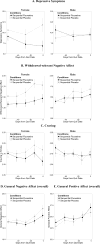Effects of sequential fluoxetine and gender on prequit depressive symptoms, affect, craving, and quit day abstinence in smokers with elevated depressive symptoms: a growth curve modeling approach
- PMID: 25089930
- PMCID: PMC4428342
- DOI: 10.1037/a0037156
Effects of sequential fluoxetine and gender on prequit depressive symptoms, affect, craving, and quit day abstinence in smokers with elevated depressive symptoms: a growth curve modeling approach
Abstract
Although the important roles of postquit affect and withdrawal symptoms in the process of smoking cessation have been well established, little is known about the relations between prequit affective trajectories and cessation outcome on the target quit date (TQD). This study examined whether a 16-week course of fluoxetine initiated 8 weeks prequit ("sequential" fluoxetine) improved TQD abstinence relative to placebo through its effects on prequit depressive symptoms, affect (withdrawal-relevant negative affect, general negative affect, and positive affect), and craving to smoke among 206 smokers with elevated depressed symptoms. The moderating effects of gender were also examined. In total, 83 smokers (40%) failed to achieve abstinence on TQD, with no difference between treatment conditions or gender. Overall structural equation models showed that fluoxetine had significant indirect effects on TQD abstinence through changes in prequit withdrawal-relevant negative affect and craving, but not depressive symptoms. However, multigroup analyses revealed gender differences. Sequential fluoxetine reduced prequit depressive symptoms, withdrawal-relevant negative affect, and craving only among women. Reduction in prequit depressive symptoms and craving among women, and withdrawal-relevant negative affect among men was associated with TQD abstinence. Moreover, exploratory analysis showed negative trend-level indirect effects of fluoxetine on TQD abstinence via increased side effects, regardless of gender. This study demonstrated the importance of considering gender when examining treatment efficacy. Identifying ways to further reduce prequit depressive symptoms and craving for women and withdrawal-relevant negative affect for men whereas alleviating side effects may help smokers with elevated depressed symptoms achieve the first smoking cessation milestone.
(PsycINFO Database Record (c) 2014 APA, all rights reserved).
Figures



References
-
- Asparouhov T, Muthén BO. Weighted least squares estimation with missing data. 2010 Retrieved from http://www.statmodel.com/download/GstrucMissingRevision.pdf.
-
- Baker TB, Piper ME, McCarthy DE, Majeskie MR, Fiore MC. Addiction motivation reformulated: an affective processing model of negative reinforcement. Psychological Review. 2004;111(1):33–51. - PubMed
-
- Benjet C, Wagner FA, Borges GG, Medina-Mora ME. The relationship of tobacco smoking with depressive symptomatology in the Third Mexican National Addictions Survey. Psychological Medicine. 2004;34(5):881–888. - PubMed
-
- Blondal T, Gudmundsson LJ, Tomasson K, Jonsdottir D, Hilmarsdottir H, Kristjansson F, Bjornsdottir US. The effects of fluoxetine combined with nicotine inhalers in smoking cessation: A randomized trial. Addiction. 1999;94(7):1007–1015. - PubMed
Publication types
MeSH terms
Substances
Grants and funding
LinkOut - more resources
Full Text Sources
Other Literature Sources
Medical

